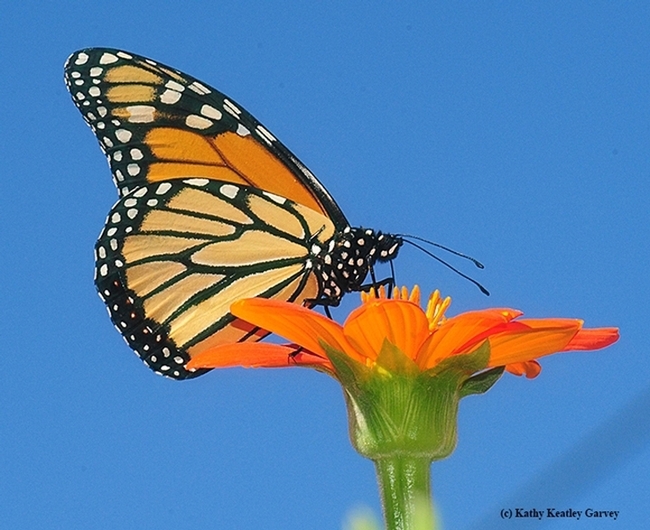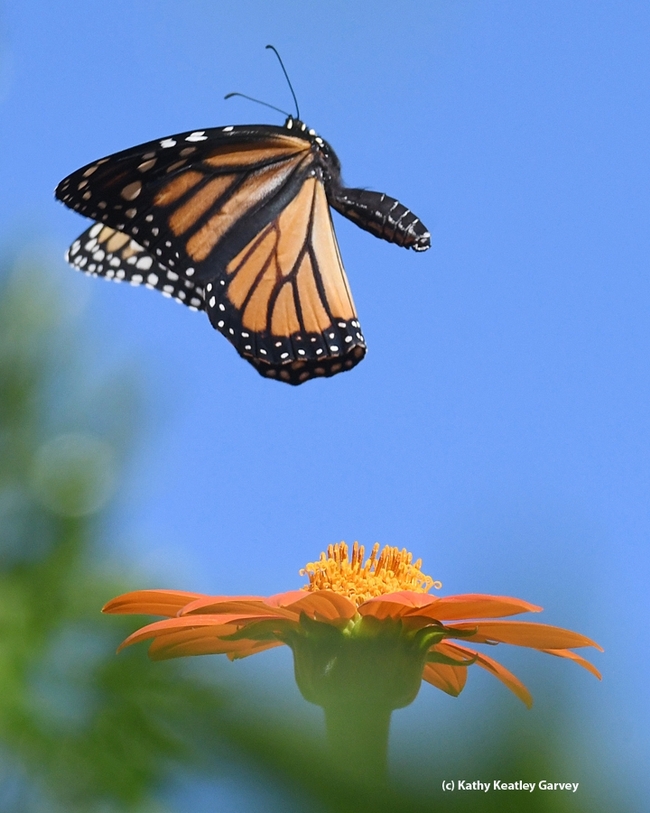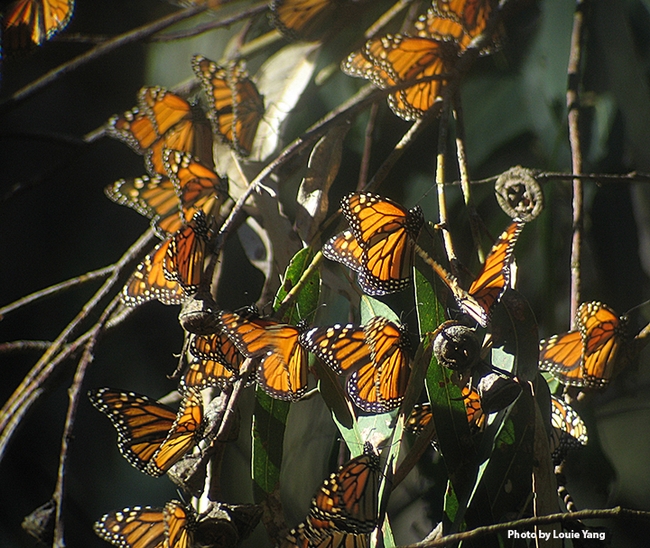
California's 2021 western monarch Thanksgiving count, directed by the Xerces Society of Invertebrate Conservation, recorded 250,000 overwintering monarchs, as compared to a mere 2000 in 2020.
Executive producer and host Ira Flatow of Science Friday set out to "unpack the news" for his listeners. On Feb. 4, he interviewed community ecologist Louie Yang, professor, UC Davis Department of Entomology and Nematology, and a faculty member of the Center for Population Biology. (Listen to the interview, 'How Long Will California's Butterfly Boom Last?')
"OK, so how did the population bounce back so dramatically?" Flatow asked. "And is this number a blip on the radar or the start of better times for the beleaguered butterfly? Here to help us unpack the news, Dr. Louie Yang, a professor and ecologist at the Department of Entomology and Nematology, UC Davis."
"It seems reasonable to say that an increase of this magnitude would probably require a series of fortunate conditions throughout the breeding season that would sustain population growth across multiple generations," the UC Davis professor told him, adding "What we've seen is a long-term trajectory of declining populations, even before the recent population variability."
Yang focuses his research on "understanding the seasonal dynamics of milkweed-monarch interactions. How do monarch caterpillars develop on their milkweed host plants? And what are the conditions that allow them to develop well and survive to adulthood? And what are the conditions that cause lower survivorship?"

Bottom line. The 100-fold increase in monarch population may or may not be a sign of what's to come. As Yang said: "So we shouldn't be complacent or assume that populations will always bounce back from low densities...I think a lot of folks are breathing a sigh of relief that the population has increased as much as it has over the past year. And I think we all share that sense of relief and joy that the population has increased. But also, there is that note of caution that there is a lot about the dynamics of this population that we don't yet understand and we're still working on."
Social media responses to the podcast included: "Great podcast! I learned even more today about the timing of milkweed availability and monarch eggs--now I understand why late season eggs have a higher percentage of survivorship. Everyone should listen to Professor Yang's interview. It's just a little over 10 minutes, but packed full of information."
Louie Yang
Yang, who joined the UC Davis faculty in 2009, holds a bachelor's degree in ecology and evolution from Cornell University, (1999) and a doctorate from UC Davis (2006).
Lauded for his advising and teaching skills, in 2018 Yang received an international award from NACADA, also known as the Global Community for Academic Advising. He co-founded and co-directs the campuswide program, Research Scholars Program in Insect Biology, with UC Davis distinguished entomology professor Jay Rosenheim and professor Joanna Chiu, vice chair of the UC Davis Department of Entomology and Nematology,
Yang, born in Australia but raised in West Virginia, says on his website: "When I was in elementary school, I wanted to be a pet shop owner. In high school, I wanted to be a veterinarian. As a college freshman, I thought I wanted to make nature documentary films. As it turns out, I was really interested in ecology and evolution. After I graduated, I traveled and started a PhD. I've been faculty at the University of California, Davis since 2009. I'm still learning new things all the time."
His current research?"I am working to develop a temporally explicit view of ecology that examines how ecological communities combine complex, coordinated and changing interactions over time. I am particularly interested in the effects of climate change on species interactions, community responses to strong perturbation events, phenological cues and phenological shifts, and seasonal changes in the nature and outcomes of species interactions. I study several different organisms in a wide range of ecological communities, each of which contributes to a broader understanding of how species interactions change over time." (See The Yang Lab website.)
So, in today's Bug Squad, a brief spotlight on Professor Yang:
Question: "How long have you been doing scientific research on monarchs?"
Answer: "I visited the overwintering monarch population at the Coronado Butterfly Preserve in Santa Barbara in 2006, and I started doing research with them shortly afterwards."

A: "Because monarch can travel long distances, it struck me that when they leave their overwintering grounds they might not have very good information about the environmental conditions at their destination. It seems like this lack of information could create the potential for phenological mismatches between the monarch and its host plant."
Q: "What are some of the results?"
A: "Broadly, our results indicate that western monarchs show “seasonal windows of opportunity”--periods in the year with increased developmental prospects. These seasonal windows are constrained by a combination of abiotic (i.e., climatic), bottom-up (i.e., host plant-related), and top-down (i.e., natural enemies-related) factors. In our region, we see two windows of opportunity (late spring/early summer and late summer/early fall) separated by a 'mid-summer slump' on their most common host plant, narrow-leaved milkweed (Asclepias fascicularis). However, plant traits matter: for example, the defensive traits of showy milkweed (Asclepias speciosa) tend to increase across the season, and the monarchs on this species only seem to show one early season window. On showy milkweed, success in the late season window seems to be constrained by host plant defensive traits. Our work has also shown that these seasonal windows appear to be constrained by different factors in the early and late part of each breeding season, and that climatic variation strongly shapes the timing and relative importance different limiting factors."
Q: "What is the role of tropical milkweed, Asclepias curassavica, in monarch conservation?"
A: "I've not studied this in detail myself, but there is a concern that tropical milkweed could change the life history of western monarchs and expose them to more diseases. Unlike our native milkweeds, tropical milkweeds don't senesce during the winter. They continue to grow year-round and are very attractive to monarchs. As a result, this non-native host plant might encourage monarchs to continue breeding longer into the winter than the would normally. In addition, because these milkweeds persist year after year, there are concerns that they can build up higher densities of Ophryocystis elektroscirrha spores, exposing monarch caterpillars to a greater risk of disease."
Q: "What can area residents do to help in monarch conservation?"
A: "I'd encourage folks interested in helping monarch conservation to learn as much as they can about the many and complex factors that can affect monarch populations. Recent variability in the western monarch population illustrates the potential for rapid declines and resilience in this population, but it also shows us the limits of our current understanding about the ecology of western monarchs. Ecology ain't rocket science--it is much more complicated. There is a lot we don't yet know, but there is also a lot that has become clearer over time. We probably know enough now to say that the combined and interactive effects of climate change, land use change, novel environmental chemicals and the global transport of organisms have played a role in the decline of monarch butterflies and many other insects. Scientists will continue working to understand this in more detail, but working now to limit those drivers makes sense."
Q. "What milkweed do you recommend folks should plant in Central California?"
A. "I'd encourage folks to learn about and cultivate the species of milkweed that grow wild in their local area. California has a remarkable diversity of milkweed species, and each occupies a unique niche. Websites like iNaturalist can help folks learn about the species that grow naturally in their area. Visiting established populations of wild milkweed will give folks a sense for the specific habitats that these milkweeds need to survive and thrive. The Xerces Society has also compiled some great information how and where to cultivate milkweed in California." (See Xerces Society website.)
Attached Images:
